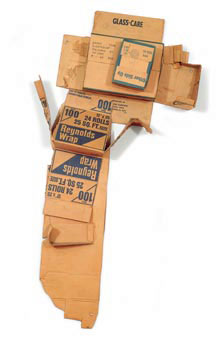February 23 – May 13, 2007
Sponsorship by TFAA and its presenting partners Schlumberger and Total E&P
 By the time Robert Rauschenberg completed the first of his Cardboards in 1971, he had already been breaking ground as an artist for twenty years. He first gained international acclaim in 1958 when he exhibited twenty of his Combines at the Leo Castelli Gallery in New York City. By amalgamating an unprecedented variety of discarded objects, materials, and artistic techniques, the Combines not only provided the first significant break with the tenets of Abstract Expressionism, but also introduced a new type of art object, neither sculpture nor painting, neither abstract nor representational.
By the time Robert Rauschenberg completed the first of his Cardboards in 1971, he had already been breaking ground as an artist for twenty years. He first gained international acclaim in 1958 when he exhibited twenty of his Combines at the Leo Castelli Gallery in New York City. By amalgamating an unprecedented variety of discarded objects, materials, and artistic techniques, the Combines not only provided the first significant break with the tenets of Abstract Expressionism, but also introduced a new type of art object, neither sculpture nor painting, neither abstract nor representational.
The Cardboards present a continuation of the found-object tradition and the exploration of the boundaries between painting and sculpture that the Combines began. The artist’s approach here, however, was radically transformed. Lacking the palate of refuse provided by New York City, Rauschenberg, who had recently moved to Captiva, Florida, turned his attention to what he discovered in his new environ. While Rauschenberg had included any and all materials in his Combines, in the Cardboards, he confined himself to only one: discarded cardboard boxes. Rauschenberg tore, flattened, bent, and cut the boxes that constitute this series; however, he resisted otherwise embellishing their surfaces. Thus, the stains, tears, dents, and marks that enliven the compositions result from, and attest to, the history of the objects themselves. He managed in this series to blend the inferior with the precious, to bring to the surface the hidden “cultural” qualities of this ordinary material by transforming it into great art.
Inspired by his new material, Rauschenberg produced a number of other series that developed the original concept in different ways. Working with the printers at Gemini G.E.L. in Los Angeles, Rauschenberg produced Cardbirds (1971-1972), a series of faux cardboard box constructions using silkscreen on cardboard. Later he collaborated with Graphicstudio at the University of South Florida to create the series Tampa Clay Pieces (1972-1973). In both of these editions, the look of ordinary cardboard boxes belies the sophisticated techniques developed by the artist and the printmakers to create them.
In the Venetian’s series (1972-1973), Rauschenberg revisited the practice of working with materials in their found state. The simple assemblages
are poetic impressions of Venice, a city whose decaying beauty struck a chord with Rauschenberg’s own aesthetic. As he had in the Cardboards, he continued to let the history of the objects inform the content and aura of the artworks, but using a wider variety of objects, he expanded the three-dimensionality of the works. Inspired by a book on Egypt, Rauschenberg created the Early Egyptians series (1973-1974). He began with the simplified, minimal look of the Cardboards, but rather than flattening the boxes, he left them intact, coating them in glue, then rolling them in sand or wrapping them in gauze like mummies.
Day-Glo paint applied to their backs casts a soft steady light onto the wall behind them when they are properly installed and lit.
Despite Rauschenberg’s fame there are still important aspects and periods of his work that are practically unknown, even to specialists. For this reason, The Menil Collection decided to organize “Robert Rauschenberg: Cardboards and Related Pieces.” In October 1971, the Leo Castelli Gallery in New York presented “Cardboards and Cardbirds,” but since then the series has largely been ignored. “Cardboards and Related Pieces” is the first museum exhibition to focus exclusively on this key yet unappreciated period in Rauschenberg’s career. The exhibition is curated by Director Josef Helfenstein and accompanied by a fully illustrated catalogue.




